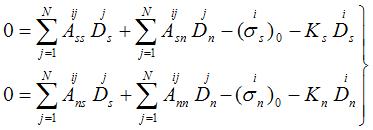SIMULATION OF ROCK DISCONTINUITIES
For a rock discontinuity (crack, joint, etc.) in an infinite elastic rock mass, the system of governing equations 2-7 can be written as
i=1 to N 2-10
where and
represent the shear and normal stresses of
the ith element respectively;
are the far-field
stresses transformed in the crack shear and normal directions.
, ...
, are the influence coefficients, and
represent
displacement discontinuities of jth element
which are unknowns in the system of equations.
A rock discontinuity has three states: open, in elastic contact or sliding.
The system of governing equations 2-10, developed for an open crack, can be
easily extended to the case for cracks in contact and sliding. For different
crack states, their system of governing equations can be rewritten in the
following ways, depending on the shear and normal stresses ( and
) of the
crack.
- For an open crack
=
= 0, therefore the system of governing equations 2-10 can be rewritten as:
i=1 to N 2-11
- When the two crack surfaces
are in elastic contact, the magnitude of
and
will depend on the crack stiffness (Ks, Kn) and the displacement discontinuities (
)
2-12
where Ks and Kn are the crack shear and normal stiffness, respectively. Substituting Equation 2-12 into Equation 2-10 and carrying out the simple mathematical manipulation, the system of governing equations then becomes:
 i=1 to N 2-13
i=1 to N 2-13
- For a crack with its surfaces sliding
2-14
where φ is the friction angle of the crack urfaces. The sign of depends on the sliding direction. Consequently, the system of equations 2-10 can be presented as:
i=1 to N 2-15
The displacement discontinuities () of the crack
are obtained by solving the system of governing equations using conventional
numerical techniques, e.g. Gauss elimination method. If the crack is open the
stresses (
,
) on the crack surfaces are zero, otherwise
if the crack is in contact or sliding, they can be calculated by Equations 2-12
or 2-14.
The state of each crack (joint) element can be determined using the Mohr-Coulomb failure criterion:
1. open
joint: ![]()
2. elastic
joint: ![]() ,
, ![]()
3 sliding joint:![]() ,
, ![]()
where a compressive stress is taken to be negative and c is cohesion. If the joint has experienced sliding, c = 0.